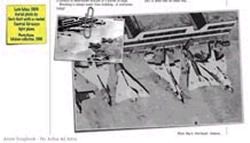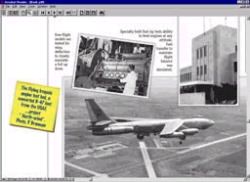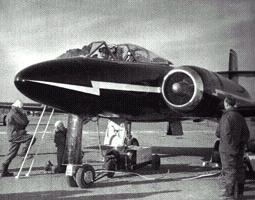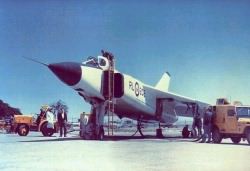By: Len 'Viking1' Hjalmarson
Date: 1999-07-15
"Nobody told us we couldn't do it."
- Jim Floyd, speaking about his days at Avro.
In April, 1924, the Royal Canadian Air Force was born. Barely thirty years later, Canadian Engineers were drawing up plans for an advanced jet Interceptor. The engines to power this craft were two generations beyond anything that had yet seen the light of day.
1999 is the 75th Anniversary of the RCAF, now known simply as the air division of the Canadian Armed Forces. It's a proud history, but it is marred by political interference of colossal proportions. The Arrow Scrapbook celebrates a Canadian achievement that was killed by lack of foresight on the part of a few men.
Yet was it simply lack of foresight, or were there larger forces at work? There is mystery and even some intrigue surrounding the cancellation of the Arrow. Peter Zuuring's scrapbook does justice to the events and the context of the times, and goes far beyond any other collection yet seen in documenting these events.

The press release for the Arrow Scrapbook calls this "the Definitive collection of original documents, rarely seen photos,drawings, letters, and more..." Be assured that this is not an exaggeration. The Scrapbook comprises more more than 500 original documents and previously unpublished photos, drawings, letters. As if that weren't enough, there are also newly declassified Diefenbaker Cabinet minutes, and more.
The Scrapbook follows Arrow enthusiast and author, Peter Zuuring, as he uncovers lost parts, drawings, plans and models in government institutions, warehouses and private basements. Zuuring's research overturns previously accepted Arrow doctrine, such as:
- Diefenbaker cancelled it
- The U.S. manipulated the cancellation

B-47 being powered by the Iroqouis jet engines slated to power the prodution version of the Arrow.
But there are other popular myths that are also quashed by Zuuring's investigations:
- It cost too much and Canada couldn’t afford it
- Nobody wanted it
- It would have fallen apart
- Nothing was saved
- It was 20 years ahead of its time
It's a fascinating read, and if you have an interest in military aviation or aviation history, it's a must read. The biggest surprise for some will be learning about plans to rebuild the Arrow as a National project ready to celebrate 100 years of flight in Canada, in 2009. The following is excerpted by permission of the Arrow Alliance.

By the early 1950s, A.V. Roe Canada Limited had several successes behind it. The first North American passenger Jetliner had flown, and the pre production models of the first all-weather subsonic fighter-interceptor, the CF-100 Canuck, were complete. Full production was being sorted out, although not without some major problems. The management team that was to oversee the Arrow program was in place, while government work provided an ever-increasing cash surplus.
Even before the CF-100 was proven and in service, a supersonic replacement was being discussed to meet the ever-changing Soviet threat. Avro, as a forward-thinking company, would not lose the opportunity to make its interests known. In 1951, it submitted a brochure detailing three possible solutions. The Royal Canadian Air Force responded in 1952 with a requirements document that led to Avro winning a design-study contract the following year.
While these "blue sky" discussions were going on, disturbing events were unfolding for the military and the company. CF-100 design flaws and production delays occupied the minds of the RCAF and its political masters.
The outbreak of the Korean War did not make things any easier. The Jetliner was sitting unsold because of war production restrictions in the United States, while in Canada an unimaginative Trans-Canada Airlines and a preoccupied military bought foreign equipment (the Viscount and the ill fated Comet both from the United Kingdom).
C.D. Howe, the federal "Minister of Everything," told Avro that as long as the government was paying the bills, fixing the CF-100 was the first priority and forget about anything else. In one stroke, any potential commercial airline business was left in the dust.

Photo Avro Aircraft Corp.
It took thousands of engineering changes over two years - from June 1950 when the first production orders were given to July 1952 - for the first CF-100 (18108) to be delivered to the RCAF. Returned aircraft in the interval had suffered from bent wings, popped rivets and shoddy workmanship.
Cockpit pressurization problems may have caused the first Canuck crash on April 5, 1951, which killed both pilot and observer. Understandably, the company cancelled its plan to show the CF-100 at the Farnborough air show that year.

In the House of Commons, politicians berated Howe by saying that the CF 100 project, if not a fiasco, was at least an excessively costly experiment ($100 million to date). It was so far behind schedule that there was real danger of obsolescence before delivery - something like the "being taken over by events" that the company would hear in years to come.
Even though the CF-100 problems were resolved with time, lingering seeds of doubt were sown with respect to the company's engineering, design, manufacturing and program management. These doubts would later become a factor in the cancellation of a much more promising and much more expensive program.
And that is how the Arrow story unfolds in the early pages of the Scrapbook. I enjoyed this read immensely. In fact, it was one of those "I can't put it down" experiences. Highly recommended, and you may order directly from the Arrow Alliance for $40 Canadian. All profits go directly to the main project: rebuilding an operable Arrow!
Go to Arrow Alliance.